 BUY IT FROM AMAZON: RIGHT HERE!
BUY IT FROM AMAZON: RIGHT HERE!
PLATFORM: XBox 360, PS3 (reviewed), PC
PRICE: $59.99
ESRB RATING: M
DEVELOPER: Volition
PUBLISHER: Deep Silver
Back when Volition announced a hard and fast release date for Saints Row IV, a shade under a month from the massive Lovecraftian shoggoth hellbeast that is GTA V, it was assumed this was the year when the upstart open world crime franchise would get in big bad GTA‘s face and show it how far it’s come from the days when it was generally considered a No Frills version of San Andreas. As it turns out, Saints Row IV isn’t even operating in the same circles as GTA anymore. Logic dictates that the fight would be between Saints Row IV and Crackdown, Infamous and Prototype now. You’d be right, except for the fact that Saints Row IV absolutely bitchslaps all three series. Saints Row IV is better. Better than the Saints Rows that came before. Better than every superhero game that’s come prior. It is bigger, more ambitious, funnier, occasionally even smarter. Most importantly, it is massive, ridiculous, enormous piles of fucking FUN.
 SRIV makes no bones at the outset of this being adamantium grafted on the skeleton of Saints Row The Third. With some scattered additions, the graphics engine is the same, the character customization is the same, the controls are essentially the same. For the folks playing through The Third right now, this will be a pick-up-and-play title, and if not for the fact that it starts with defusing a nuclear bomb over the White House while I Don’t Wanna Miss A Thing plays, it would actually be somewhat disappointing for the first couple of hours. It also shows the signs, and shows them often, of being an engine that occasionally shudders under the weight, given the number of bugs and weird glitches that crop up. But this is a game built from the ashes of an ill-fated DLC called Enter The Dominatrix, after all, so we know something’s gotta give, and it does in a hurry. The Boss, now President Boss, is handling presidential shit, when an alien civilization called the Zin invades Earth during a White House press conference, enslaves the populace, and thrusts them all into a dismal, red sky, virtual Steelport full of propaganda, alien technology, and the wonkiest computer programming since Windows 98. President Boss is abducted, along with his/her entire cabinet, and sent to their own private hellscape; the Boss to a terrifyingly goofy Pleasantville knock off–the game would be worth $60 by itself if you got to keep the Boss’ hilarious strut here the entire game–Shaundi to the moment she left Johnny Gat to die, Pierce to have the shit kicked out of him by giant size cans of Saints Flow. The private hells get far more inventive and insane and self-referential than that, and under no circumstances should you allow yourself to have them spoiled for you. Especially a certain 16-bit one. Either way, The Boss is the first one out, of course, as Kinzie hacks into the simulation, breaks open The Boss’ Matrixy Jell-O pod, and sends him/her right back into Steelport to free the minds of the other Saints and wreak major havoc in search of some almighty revenge.
SRIV makes no bones at the outset of this being adamantium grafted on the skeleton of Saints Row The Third. With some scattered additions, the graphics engine is the same, the character customization is the same, the controls are essentially the same. For the folks playing through The Third right now, this will be a pick-up-and-play title, and if not for the fact that it starts with defusing a nuclear bomb over the White House while I Don’t Wanna Miss A Thing plays, it would actually be somewhat disappointing for the first couple of hours. It also shows the signs, and shows them often, of being an engine that occasionally shudders under the weight, given the number of bugs and weird glitches that crop up. But this is a game built from the ashes of an ill-fated DLC called Enter The Dominatrix, after all, so we know something’s gotta give, and it does in a hurry. The Boss, now President Boss, is handling presidential shit, when an alien civilization called the Zin invades Earth during a White House press conference, enslaves the populace, and thrusts them all into a dismal, red sky, virtual Steelport full of propaganda, alien technology, and the wonkiest computer programming since Windows 98. President Boss is abducted, along with his/her entire cabinet, and sent to their own private hellscape; the Boss to a terrifyingly goofy Pleasantville knock off–the game would be worth $60 by itself if you got to keep the Boss’ hilarious strut here the entire game–Shaundi to the moment she left Johnny Gat to die, Pierce to have the shit kicked out of him by giant size cans of Saints Flow. The private hells get far more inventive and insane and self-referential than that, and under no circumstances should you allow yourself to have them spoiled for you. Especially a certain 16-bit one. Either way, The Boss is the first one out, of course, as Kinzie hacks into the simulation, breaks open The Boss’ Matrixy Jell-O pod, and sends him/her right back into Steelport to free the minds of the other Saints and wreak major havoc in search of some almighty revenge.
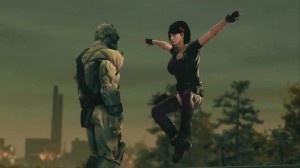 With the Matrix references come the Matrix powers, and if I were a Shiny/Atari employee, I would be looking for the nearest sharp object to seppuku-a-go-go with. I’ll grant that Enter The Matrix and Path of Neo, being close to a decade old at this point, never had the horsepower to pull off something this huge, but, the ambition of doing it would’ve meant the world. The second you run up the side of a skyscraper, jump off, come careening down at 200 miles an hour, damaging every enemy within earshot, and whip out the double pistols to finish off anyone who didn’t have the good sense to die when you made landfall, those two games’ failures become immediately inexcusable. This game is EVERYTHING a Matrix title should’ve been. Once the Boss is back in the simulation, the game takes off Saints Row The Third‘s earthbound shackles to let the player soar, glide, and speed at hundreds of miles an hour around Steelport. The feeling of freedom granted by the mechanics here is unprecedented. It is fast, it is fluid. How the player handles every encounter, obstacle, and challenge in the city is up to the imagination. You can’t dodge bullets (although the animation from the movie is in the game as a taunt, complete with a hilarious “I’M DODGING EVERYTHIIIING!” soundbyte from the Boss), but you’re not being hamstrung by enemies who need to be taken out one way, and one way only. You’re not stuck in one area of the city for arbitrary reasons. You’re not having your freedom in the open world stripped away for extended stretches without good reason, and by good reasons, I mean that instead of an assortment of guns and superpowers, the game may give you a UFO to fly, or a giant mech to fuck around in, or a person’s psyche to explore, or a text adventure to try and solve. Even then, you still have a picnic basket of killing and maneuvering options to deal with whatever the game throws at you. Just like the character design, your particular brand of super is indeed yours, and there isn’t a weak option in the lot, be it just going for the plain old headshot, tossing vehicles at enemies, setting them on fire with your mind, or using super strength to lay a Hulk-to-Loki shit-ruining slam on an annoying enemy. You even still have the option of being boring, since IV has the same assortment of cars, bikes, tanks, etc as The Third to use out in the world. If you’re boring. Why spend 10 minutes sitting and steering in traffic when you can pretend you’re the Flash and run rings around the city in half the time? Hell, the game even allows you to listen to the radio stations outside of vehicles for that very reason.
With the Matrix references come the Matrix powers, and if I were a Shiny/Atari employee, I would be looking for the nearest sharp object to seppuku-a-go-go with. I’ll grant that Enter The Matrix and Path of Neo, being close to a decade old at this point, never had the horsepower to pull off something this huge, but, the ambition of doing it would’ve meant the world. The second you run up the side of a skyscraper, jump off, come careening down at 200 miles an hour, damaging every enemy within earshot, and whip out the double pistols to finish off anyone who didn’t have the good sense to die when you made landfall, those two games’ failures become immediately inexcusable. This game is EVERYTHING a Matrix title should’ve been. Once the Boss is back in the simulation, the game takes off Saints Row The Third‘s earthbound shackles to let the player soar, glide, and speed at hundreds of miles an hour around Steelport. The feeling of freedom granted by the mechanics here is unprecedented. It is fast, it is fluid. How the player handles every encounter, obstacle, and challenge in the city is up to the imagination. You can’t dodge bullets (although the animation from the movie is in the game as a taunt, complete with a hilarious “I’M DODGING EVERYTHIIIING!” soundbyte from the Boss), but you’re not being hamstrung by enemies who need to be taken out one way, and one way only. You’re not stuck in one area of the city for arbitrary reasons. You’re not having your freedom in the open world stripped away for extended stretches without good reason, and by good reasons, I mean that instead of an assortment of guns and superpowers, the game may give you a UFO to fly, or a giant mech to fuck around in, or a person’s psyche to explore, or a text adventure to try and solve. Even then, you still have a picnic basket of killing and maneuvering options to deal with whatever the game throws at you. Just like the character design, your particular brand of super is indeed yours, and there isn’t a weak option in the lot, be it just going for the plain old headshot, tossing vehicles at enemies, setting them on fire with your mind, or using super strength to lay a Hulk-to-Loki shit-ruining slam on an annoying enemy. You even still have the option of being boring, since IV has the same assortment of cars, bikes, tanks, etc as The Third to use out in the world. If you’re boring. Why spend 10 minutes sitting and steering in traffic when you can pretend you’re the Flash and run rings around the city in half the time? Hell, the game even allows you to listen to the radio stations outside of vehicles for that very reason.
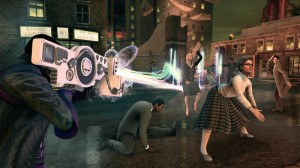 You start out with the usual smattering of guns, with the added twist that all the guns now have skins you can put on so that your average pistol can be Deckard’s gun from Blade Runner, or you can use the Heavy’s shotgun from Team Fortress 2. Later on, the game starts putting the fun back in function. The now-trademark Dubstep Gun is a highlight, due to sheer effectiveness combined with, well, being a Dubstep Gun, especially since the skins allow you to change the weapon’s tune in case you get tired of it, but being able to say, pull a Duck Dodgers and disintegrate an enemy, or create your own black holes has its merits as well, to say the least. With that kind of weaponry at the player’s disposal, you’d think the game would be a cakewalk and you would be dead wrong. In previous games, once the Boss found a killer weapon, you could pretty much run roughshod over the rest of the game with it and never switch. Here, the XP system from The Third is back, but it now extends to the guns as well, where every weapon starts out at the weakest possible level, and the player has to work their ass off to reach full lethality. The upgrades aren’t impossible, but they aren’t cheap, especially if you want the best extras, like the Dubstep Gun having explosive wubs, or having every enemy you kill with a rifle give you automatic health. The superpowers function much the same, where once the basic version has been obtained, to become the badass you want to be, you’re going to work for it. None of the work is tedious due to just how fun the game’s myriad activities are with even the most basic powers, but there’s a world of difference between being able to jump really high, and being able to leap tall buildings in a single bound, and the second you find out what’s required to get your dream power, you’ll drop everything to get it.
You start out with the usual smattering of guns, with the added twist that all the guns now have skins you can put on so that your average pistol can be Deckard’s gun from Blade Runner, or you can use the Heavy’s shotgun from Team Fortress 2. Later on, the game starts putting the fun back in function. The now-trademark Dubstep Gun is a highlight, due to sheer effectiveness combined with, well, being a Dubstep Gun, especially since the skins allow you to change the weapon’s tune in case you get tired of it, but being able to say, pull a Duck Dodgers and disintegrate an enemy, or create your own black holes has its merits as well, to say the least. With that kind of weaponry at the player’s disposal, you’d think the game would be a cakewalk and you would be dead wrong. In previous games, once the Boss found a killer weapon, you could pretty much run roughshod over the rest of the game with it and never switch. Here, the XP system from The Third is back, but it now extends to the guns as well, where every weapon starts out at the weakest possible level, and the player has to work their ass off to reach full lethality. The upgrades aren’t impossible, but they aren’t cheap, especially if you want the best extras, like the Dubstep Gun having explosive wubs, or having every enemy you kill with a rifle give you automatic health. The superpowers function much the same, where once the basic version has been obtained, to become the badass you want to be, you’re going to work for it. None of the work is tedious due to just how fun the game’s myriad activities are with even the most basic powers, but there’s a world of difference between being able to jump really high, and being able to leap tall buildings in a single bound, and the second you find out what’s required to get your dream power, you’ll drop everything to get it.
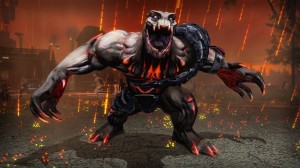 Add in the fact that your enemies aren’t pushovers by any means. The typical Zin aliens aren’t too bad, though they tend to make up for it in sheer numbers and the fact that it doesn’t take long for them to start bringing mini-tanks to every party, but then they start adding shields, enemy-spawning portals, and
Add in the fact that your enemies aren’t pushovers by any means. The typical Zin aliens aren’t too bad, though they tend to make up for it in sheer numbers and the fact that it doesn’t take long for them to start bringing mini-tanks to every party, but then they start adding shields, enemy-spawning portals, and Terminators Murderbots into the mix, and your superpowers can very easily end up not meaning shit. For a good portion of the game, every major fracas needs a gameplan, and again, that gameplan is of the player’s making, not the game forcing one power or another on you. Like the previous game, getting ragdolled, even with the new ability to flip out of it in midair and fly off, is still a cheap danger, but most of the times the game hands the player their ass have to do with not utilizing the freedom afforded to its utmost.
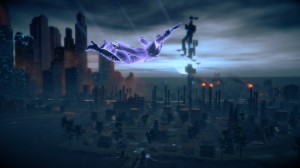 In between all the glorious killing are the random activities. A good deal of The Third‘s insanity gets traded in this time around–that means no Streaking activity, and no driving around with a tiger in the passenger seat–but you’re still dealing with some fun ways to blow five minutes. Along with the expected super-powered Mayhem missions, and the Insurance Fraud activity returning, there’s super-powered platforming, supersonic foot races, a Temple Run styled collect-a-thon, a city-wide Telekinesis-based Professor Genki activity called Mind Over Murder, Superpower Fight Club, which is exactly what it sounds like, and instead of having to save up and buy every building in sight, stores now have to be hacked, Bioshock/Pipe Dream style, in order to access them.
In between all the glorious killing are the random activities. A good deal of The Third‘s insanity gets traded in this time around–that means no Streaking activity, and no driving around with a tiger in the passenger seat–but you’re still dealing with some fun ways to blow five minutes. Along with the expected super-powered Mayhem missions, and the Insurance Fraud activity returning, there’s super-powered platforming, supersonic foot races, a Temple Run styled collect-a-thon, a city-wide Telekinesis-based Professor Genki activity called Mind Over Murder, Superpower Fight Club, which is exactly what it sounds like, and instead of having to save up and buy every building in sight, stores now have to be hacked, Bioshock/Pipe Dream style, in order to access them.
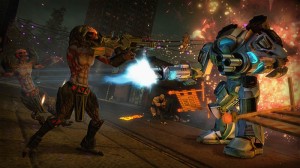 The rewards vary, but almost every activity here also fills out the list of NPC-specific activities listed on the quests screen. Every secondary character will send the Boss out to perform specific tasks, and once the current list is full, you collect a handsome prize. Sometimes it’s just a skin for a weapon, or a new doorway exit out of the simulation, or new outfit for the Boss. Sometimes it’s unlocking a gun that inflates enemies till they explode, or the ability to shoot lightning. This is another one of those things that one wonders why no one else gets right. If I’m going to be compelled to 100% a game, the incentive needs to be better than “Because it’s there”. Old Painless style chainguns that shoot lasers? That’s more than an incentive. That’s a NEED, and the game will make you work, but not grind for it.
The rewards vary, but almost every activity here also fills out the list of NPC-specific activities listed on the quests screen. Every secondary character will send the Boss out to perform specific tasks, and once the current list is full, you collect a handsome prize. Sometimes it’s just a skin for a weapon, or a new doorway exit out of the simulation, or new outfit for the Boss. Sometimes it’s unlocking a gun that inflates enemies till they explode, or the ability to shoot lightning. This is another one of those things that one wonders why no one else gets right. If I’m going to be compelled to 100% a game, the incentive needs to be better than “Because it’s there”. Old Painless style chainguns that shoot lasers? That’s more than an incentive. That’s a NEED, and the game will make you work, but not grind for it.
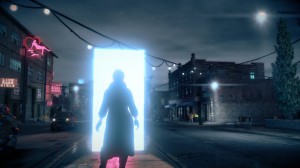 The story, as it turns out, happens to be one of those incentives this time, which is a total shock. Saints Row IV somehow acts as both the final, crucial split from anything even remotely street-level gritty about this franchise, and the loving embrace of every tonal step that got them here. It’s hard to pinpoint when I found myself truly liking the Saints as a collection of characters and personalities, but by the end, when the lot of them enter the simulation as a team of superheroes one to finally take the fight directly to the Zin, I knew it had absolutely happened. While some of the best peripheral folks from The Third are absent after the first act or absent entirely(specifically, Oleg, and autotune pimp Zimos), the people we’re left with are worth spending time with, who have chemistry, history, and some legitimately solid comedic writing and line delivery fueling it all. There’s a running gag about calling a mech a robot or power armor that is not just rapid fire chuckles in the moment, but is paid off awesomely in the third act, and plays out right before the greatest love letter to Transformers: The Movie in history happens. The series has always struggled trying to balance ridiculous, childish glee with the fact that a gangster tale is trying to unfold. In shedding that angle altogether, they’ve ironically hit the sweet spot.
The story, as it turns out, happens to be one of those incentives this time, which is a total shock. Saints Row IV somehow acts as both the final, crucial split from anything even remotely street-level gritty about this franchise, and the loving embrace of every tonal step that got them here. It’s hard to pinpoint when I found myself truly liking the Saints as a collection of characters and personalities, but by the end, when the lot of them enter the simulation as a team of superheroes one to finally take the fight directly to the Zin, I knew it had absolutely happened. While some of the best peripheral folks from The Third are absent after the first act or absent entirely(specifically, Oleg, and autotune pimp Zimos), the people we’re left with are worth spending time with, who have chemistry, history, and some legitimately solid comedic writing and line delivery fueling it all. There’s a running gag about calling a mech a robot or power armor that is not just rapid fire chuckles in the moment, but is paid off awesomely in the third act, and plays out right before the greatest love letter to Transformers: The Movie in history happens. The series has always struggled trying to balance ridiculous, childish glee with the fact that a gangster tale is trying to unfold. In shedding that angle altogether, they’ve ironically hit the sweet spot.
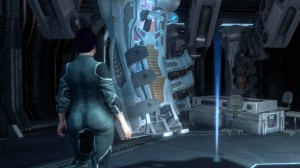 While the series’ habit of referencing other games/movies is still in full effect, if I could have diplomatic immunity on it, I would have Jason Friedman and Aaron Seltzer kidnapped, gagged, and have them sit through a playthrough of this game as a master class on how to be blatant, immature, but intelligent while still referential. Then possibly beaten with cartoon hammers for hours because, why the hell not, I’ve got them where I want them. The game’s primary sources of inspiration are obviously The Matrix and Mass Effect, with a whole host of others in between, but outside of the names for the achievements/trophies, the game never stops dead to color their parody within the lines. The Matrix stuff goes beyond just having bullet time, but to having a situation where Shaundi replays the death of Johnny Gat over and over while the dreamworld falls apart and the physics of the simulation bend to keep the Boss out, or having a 1950s sheriff in the Boss’ fucked-up Pleasantville act as an Agent. The Shaundi scene has an alternate reality twist that ends with a high speed race through the city more exhilarating and fun than anything in Man of Steel and pays off a three-game character arc in the process. There’s a scene that blatantly steals the Architect scene from Reloaded, but it is entirely focused on Zinyak, the effete British alien leader, calling the Boss out as a psychopath, displaying all his/her misdeeds in the background, and offering the option of revenge and saving an ally, or letting the Boss kill him/herself, for the sake of letting humanity go free. The response is, of course, boils down to “Fuck you”, but the simple act of catering to the need to crib while suppressing the instinct to just let the original scene play out but now with more dick and fart jokes is rather admirable. Not to say there aren’t dick jokes, mind you. They’re just much better, organic dick jokes.
While the series’ habit of referencing other games/movies is still in full effect, if I could have diplomatic immunity on it, I would have Jason Friedman and Aaron Seltzer kidnapped, gagged, and have them sit through a playthrough of this game as a master class on how to be blatant, immature, but intelligent while still referential. Then possibly beaten with cartoon hammers for hours because, why the hell not, I’ve got them where I want them. The game’s primary sources of inspiration are obviously The Matrix and Mass Effect, with a whole host of others in between, but outside of the names for the achievements/trophies, the game never stops dead to color their parody within the lines. The Matrix stuff goes beyond just having bullet time, but to having a situation where Shaundi replays the death of Johnny Gat over and over while the dreamworld falls apart and the physics of the simulation bend to keep the Boss out, or having a 1950s sheriff in the Boss’ fucked-up Pleasantville act as an Agent. The Shaundi scene has an alternate reality twist that ends with a high speed race through the city more exhilarating and fun than anything in Man of Steel and pays off a three-game character arc in the process. There’s a scene that blatantly steals the Architect scene from Reloaded, but it is entirely focused on Zinyak, the effete British alien leader, calling the Boss out as a psychopath, displaying all his/her misdeeds in the background, and offering the option of revenge and saving an ally, or letting the Boss kill him/herself, for the sake of letting humanity go free. The response is, of course, boils down to “Fuck you”, but the simple act of catering to the need to crib while suppressing the instinct to just let the original scene play out but now with more dick and fart jokes is rather admirable. Not to say there aren’t dick jokes, mind you. They’re just much better, organic dick jokes.
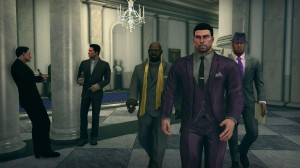 The really fun part is watching Saints Row finally parody itself in the process. More than one review had noted that a pretty big portion of Saints Row The Third had been spent quietly examining Saints Row‘s place in the gaming world as the foremost purveyor of complete open world ridiculousness, one they accepted, though with hesitations in the end, it seems. Saints Row IV represents the series hugging it out with itself. Characters, storylines, locations, tiny references from all three past games come up during the course of IV‘s campaign, from the consistent badgering of Keith David over the fact that he sounds like SR1‘s Julius (which he played), to Benjamin King coming back (voiced by Terry Crews, with previous voice, Michael Clarke Duncan getting a sweet little tribute in the end credits), to white-girl-dreads Shaundi making a return (and someone doing a spot on Eliza Dushku impression) and arguing with The Third‘s all-business version about the character change, and the leaders of every single gang fool enough to step to the Saints making an appearance. The game plays with its past, present, and future in ways that make me want to retract my previous stance, that you never needed to play Saints Row 1 or 2 to enjoy The Third. This is the game that makes it all worth it.
The really fun part is watching Saints Row finally parody itself in the process. More than one review had noted that a pretty big portion of Saints Row The Third had been spent quietly examining Saints Row‘s place in the gaming world as the foremost purveyor of complete open world ridiculousness, one they accepted, though with hesitations in the end, it seems. Saints Row IV represents the series hugging it out with itself. Characters, storylines, locations, tiny references from all three past games come up during the course of IV‘s campaign, from the consistent badgering of Keith David over the fact that he sounds like SR1‘s Julius (which he played), to Benjamin King coming back (voiced by Terry Crews, with previous voice, Michael Clarke Duncan getting a sweet little tribute in the end credits), to white-girl-dreads Shaundi making a return (and someone doing a spot on Eliza Dushku impression) and arguing with The Third‘s all-business version about the character change, and the leaders of every single gang fool enough to step to the Saints making an appearance. The game plays with its past, present, and future in ways that make me want to retract my previous stance, that you never needed to play Saints Row 1 or 2 to enjoy The Third. This is the game that makes it all worth it.
Saints Row IV is to the Saints Row franchise what Fast Five is to the Fast and the Furious franchise. This is Volition gathering all strength to them, their entire breadth of work on this series prior, learning every lesson, and finally breaking from the mold into genre freedom. The result feels like everything that’s come before, and like nothing we’ve ever seen on this scale. It is simply fucking awesome.
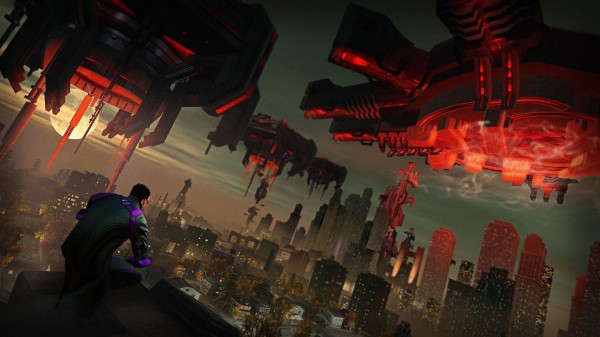
Rating: 




Out of a Possible 5 Stars
